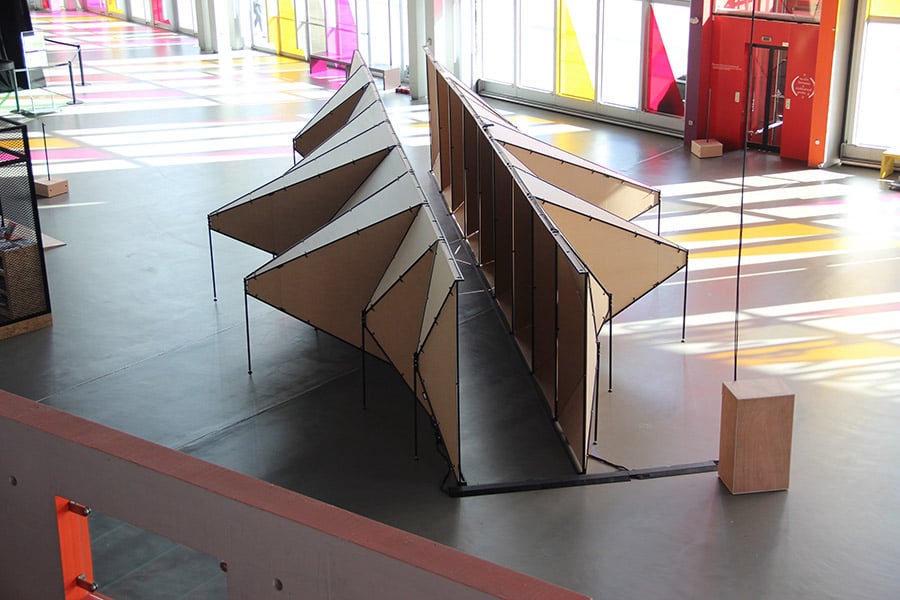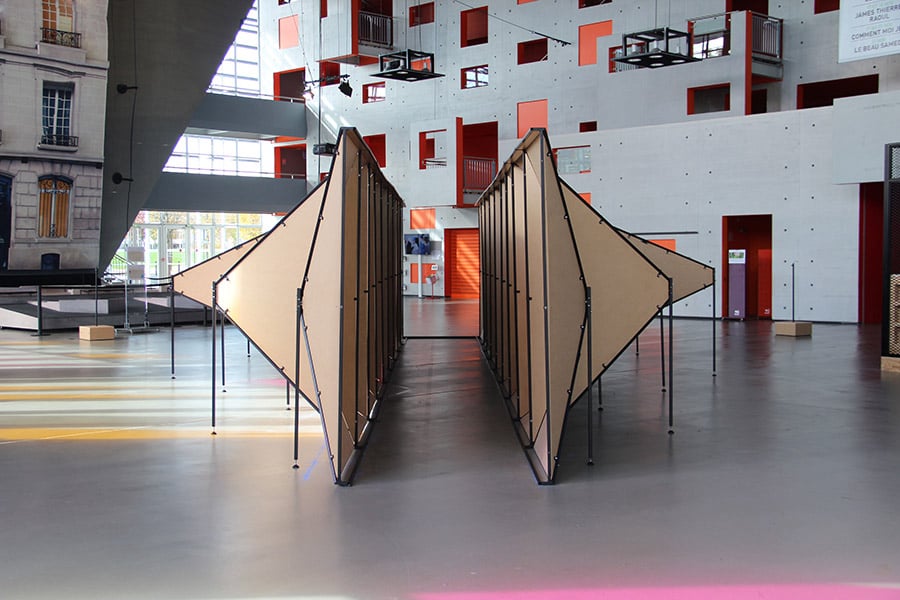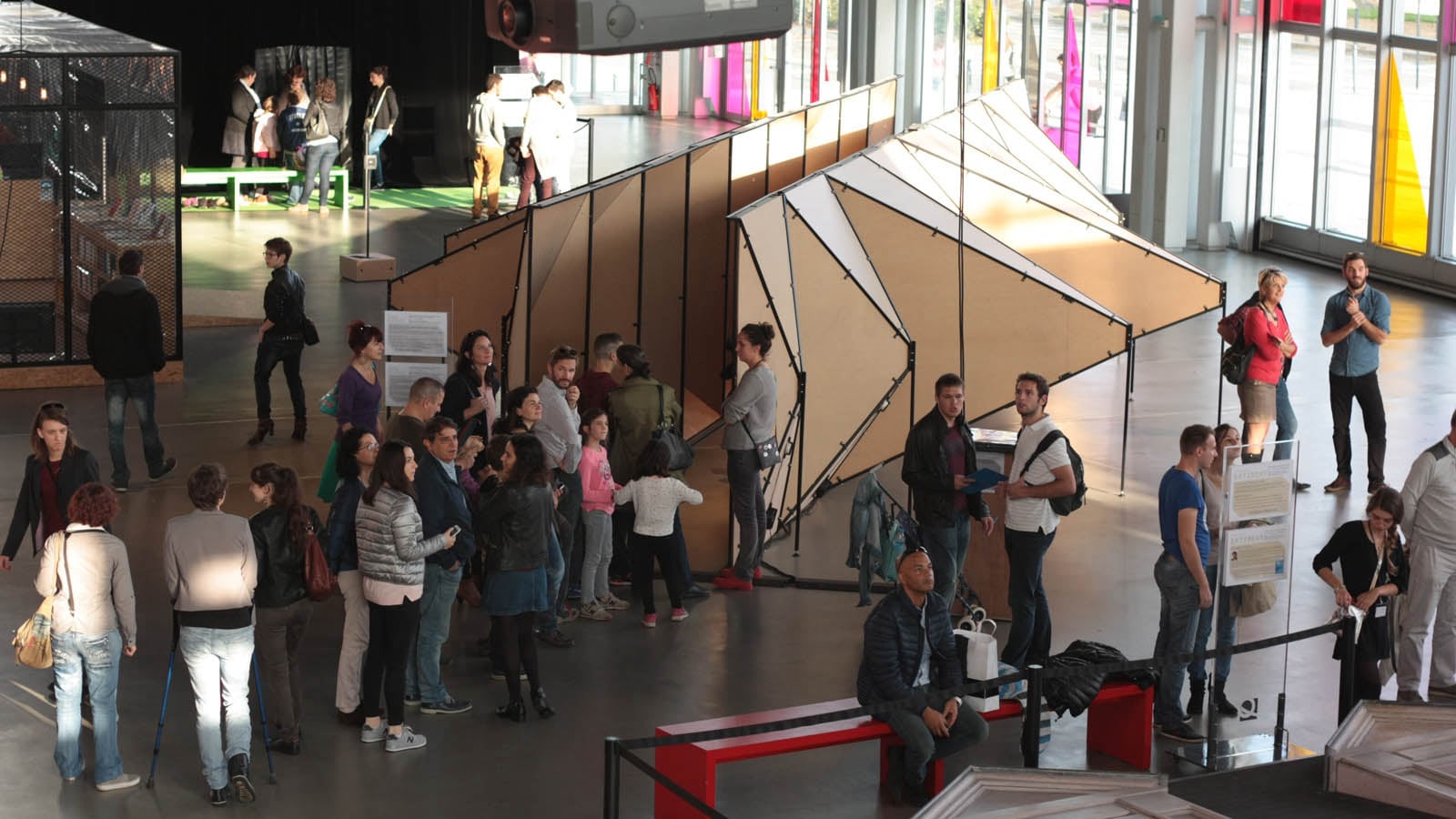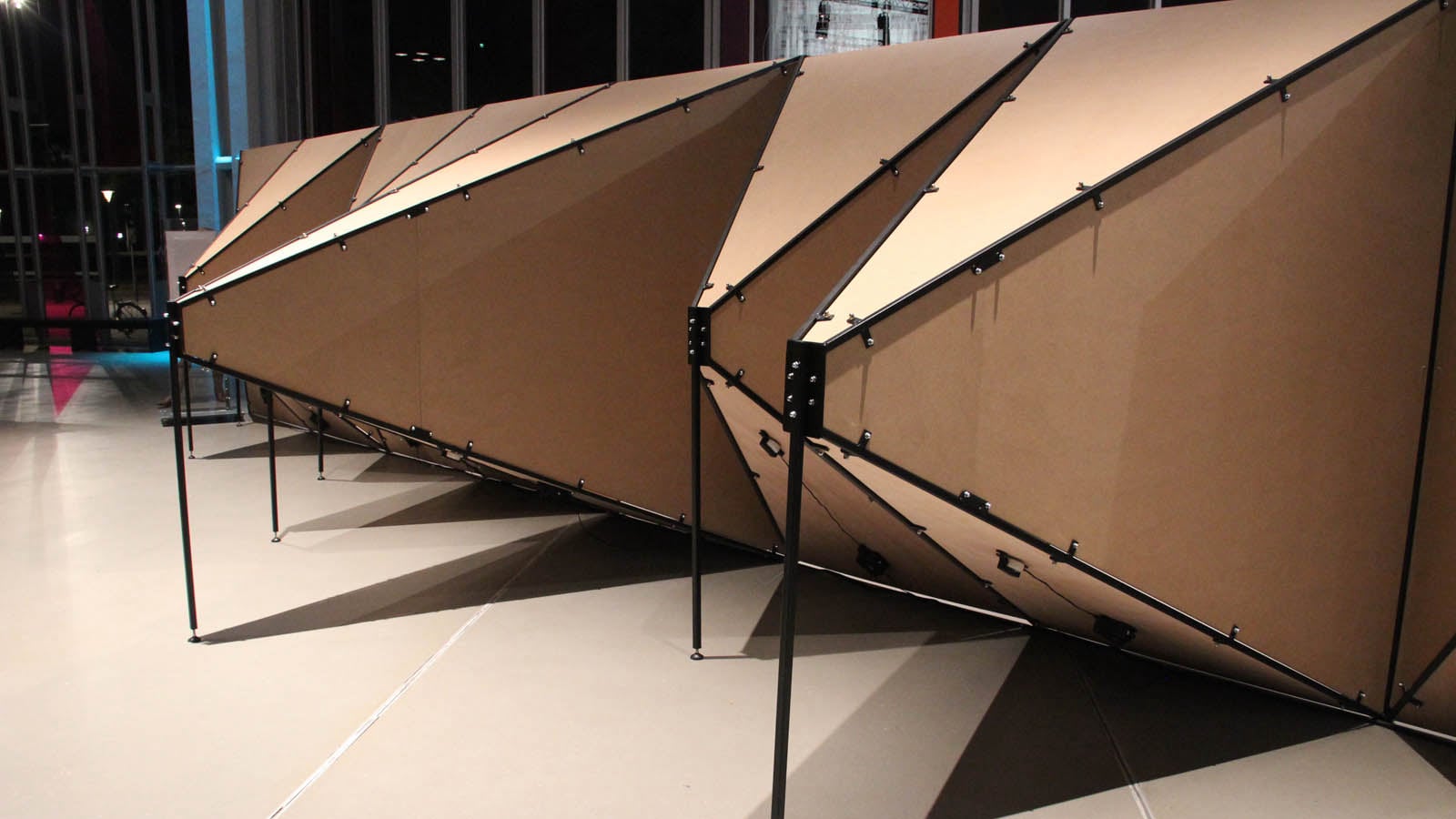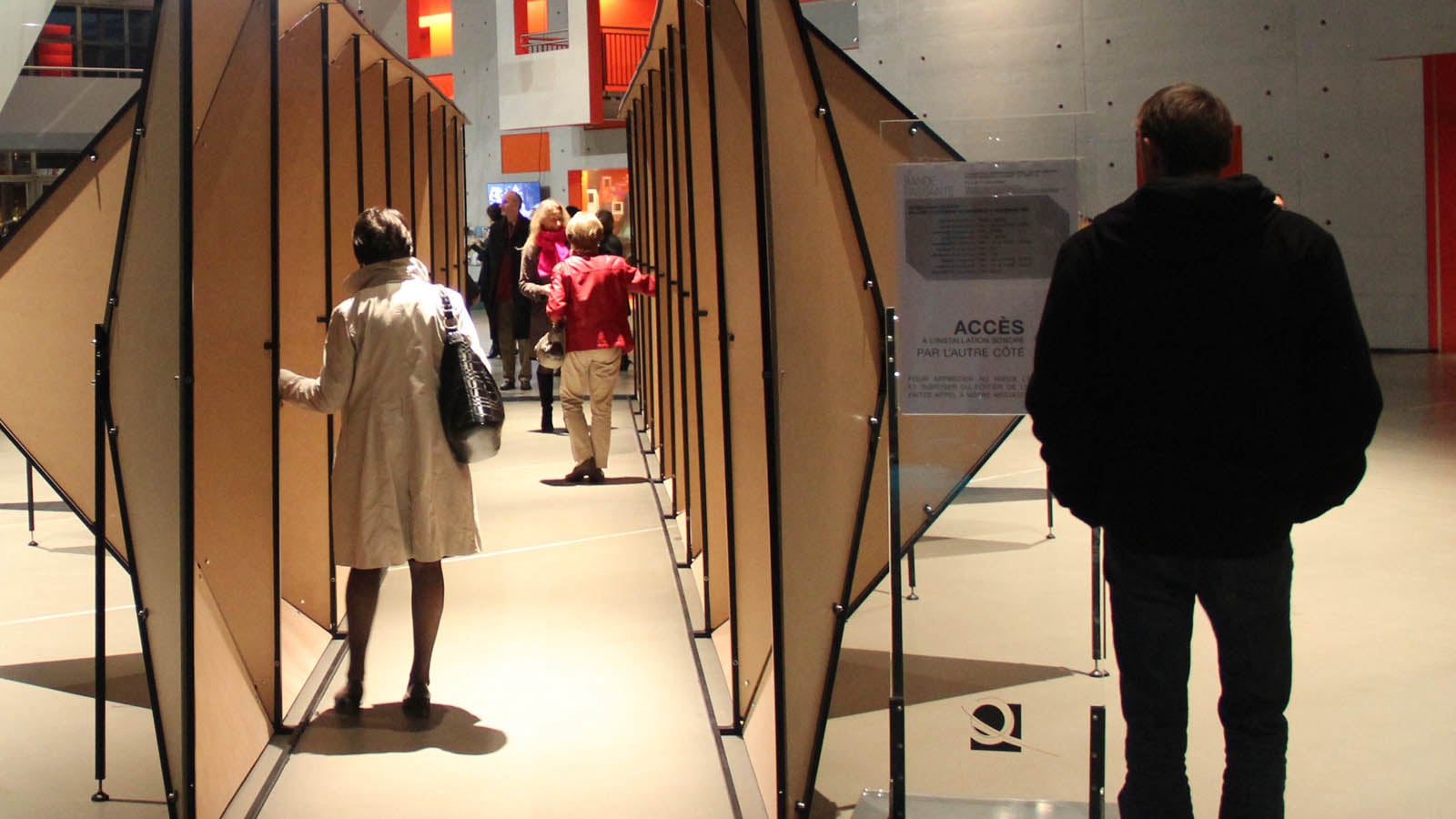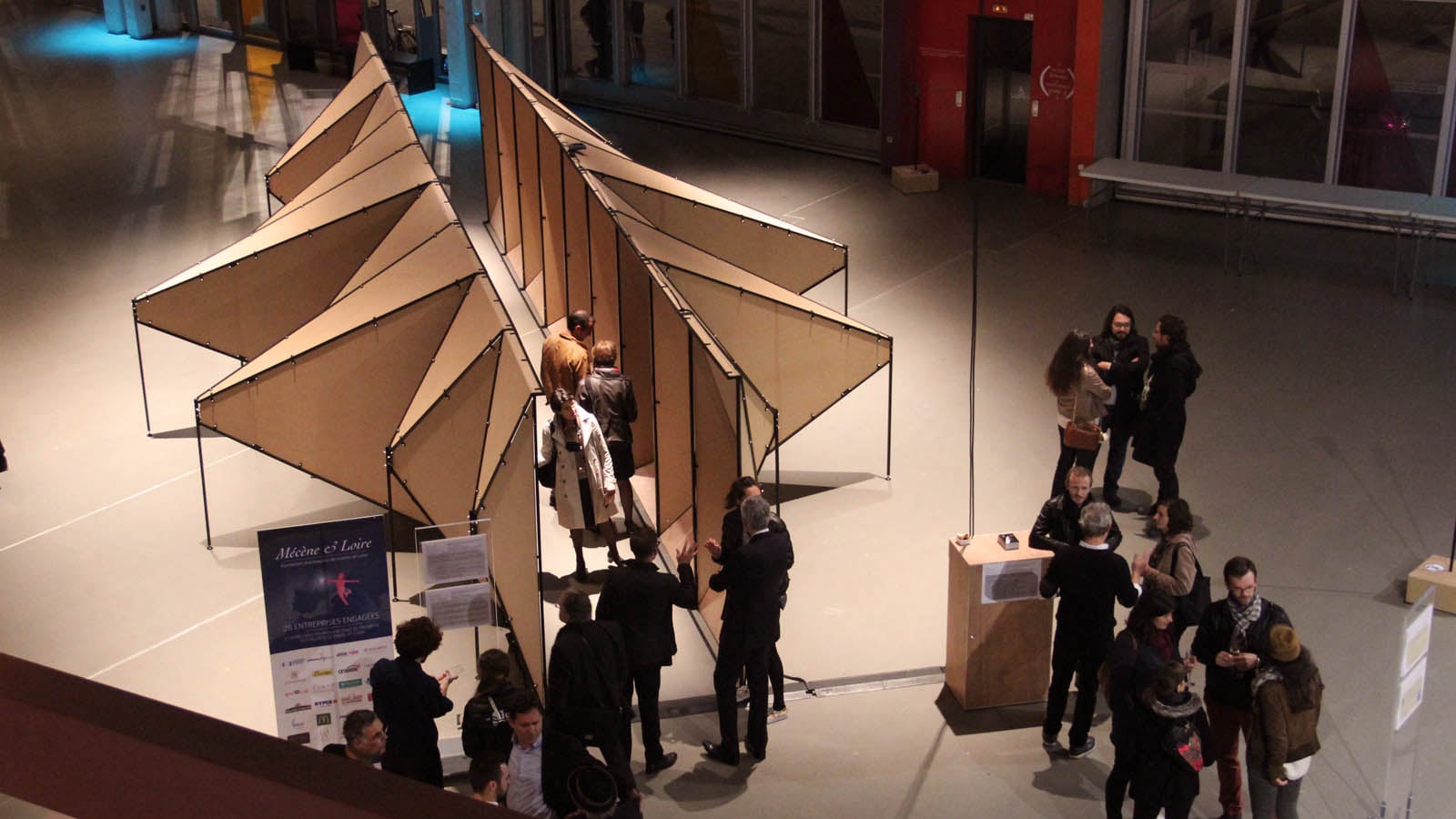La Bande Passante
PREMIERED AT THE QUAI THEATRE IN ANGERS IN NOVEMBER 2015
Winners of the 2014 "Art, Innovation and Technology" Grant from the Mécène et Loire Foundation. Thanks to Stereolux, the city of Ponts de Cé, Marty Sports, EA des BANCHAIS, S.A.A.S. This creation was supported by the DICRéAM scheme from the National Center of Cinematography.
This digital installation offers a sensory and spatial plunge into the sound spectrum. This immersion gives spectators the opportunity to explore and reinterpret the musical composition in real time.
La Bande Passante, a musical instrument in its own right, allows for a physical entry into the sound matter, with the architecture itself disseminating the score throughout the space. A simple movement is enough for the spectator to interact with the musical writing. With a gesture, they explore it, sculpt it, brush it like a bow.
Equipped with a tag, set out to explore the sound by moving around the installation, you can stop and vary the speed of your movement using this device. Very slowly or very quickly, your movements will bring you into contact with the sound matter.
EXPLOITING THE SOUND SPECTRUM THROUGH SPACE
This work offers a tactile and auditory incursion into the realm of sounds. This immersion gives participants the opportunity to redefine the musical composition in real time.
AN INTERACTIVE AND CONCRETE WORK
La Bande Passante, a musical instrument in itself, invites you to physically enter the sound universe. The architecture features a diffusion system that intensifies the tangible aspect of the experience. A simple gesture from the participant allows them to manipulate the musical composition. They can explore, sculpt, brush the music as with a bow, for a constantly renewed experience.
TOWARDS A SENSORY ARCHITECTURE
Designed without a defined entrance or exit, La Bande Passante allows multiple configurations depending on the performance context and the space it is in. The current program allows one or more users to explore the sound universe simultaneously. Ten original musical compositions are played randomly to deepen the sound experience. This scenography is thought of as a flexible listening space, adapting to the intentions of each performance. The architecture and its sound composition can adjust to the space they inhabit, thus offering an always renewed exploration.
Electroacoustics is used here to exploit the mechanical and acoustic properties of wood and amplify the signal naturally. Each module includes two vibrators (or transducers), thus eliminating the need for speakers for this performance.
The accuracy of the gesture and the comfort of the experience are amplified by the addition of two technologies. Granular Synthesis, a real digital resampling tool, allows real-time calculation of parameterized elements without loss or break in musicality. This "sound dilatation" preserves the fluidity of movement, regardless of the scenario.
A UWB (Ultra Wide Band) geolocation system completes the program. This tool generates hertzian frequencies which, after triangulation, precisely locate the participant in space and thus merge with the musical score.
The link between Sound and Space is one of the fundamental features of this approach. At the heart of all these creations, the scenography applied to theater and to the object creates what is called a "potential meeting space". His approach centers on the paradigm he establishes between space and sound. This relationship is for him a tacit law, an almost indispensable step to any project. Sound is a medium that channels many of his questionings, a medium that he integrates or not afterwards. His creations are designed in situ to respond and integrate each production more relevantly, to associate the space and the work so that a dramaturgy and a scenario can always emerge.
Installation designed by :
Olivier Brichet | Scénographe et Créateur sonore olivierbrichet
Jérémie Rigaudeau | Illustrateur et Plasticien jeremierigaudeau.fr
Xavier Seignard | Créateur d’installations interactives drangies.fr
Laurent La Torpille
CONSTRUCTION AND TECHNOLOGY
400 linear meters of metal, 500 kilograms of wood, 200 meters of wire, and more were necessary to realize this installation. We also relied on 18 transducers to achieve great sound spatialization, a UWB (Ultra Wide Band) geolocation system, and a homemade multi-user Granular Synthesis instrument.
It was a four-person job, with Olivier Brichet, Xavier Seignard, Jérémie Rigaudeau, and myself.
----
La Bande Passante
PRÉSENTÉE EN AVANT-PREMIÈRE AU THÉÂTRE LE QUAI À ANGERS EN NOVEMBRE 2015
Lauréats de la Bourse 2014 "Art, Innovation et Technologie" de la Fondation Mécène et Loire. Remerciements à Stereolux, la ville des Ponts de Cé, Marty Sports, EA des BANCHAIS, S.A.A.S. Création soutenue par le dispositif DICRéAM du Centre National de Cinématographie. Crédit photographique / La Bande Passante.
Cette installation numérique propose un plongeon sensoriel et spatial dans le spectre sonore. Cette immersion offre aux spectateurs la possibilité d‘explorer, de réinterpréter la composition musicale en temps réel.
La Bande Passante, instrument de musique à part entière, permet de rentrer physiquement dans la matière sonore, l’architecture diffusant elle-même la partition dans l’espace. Un simple mouvement suffit au spectateur pour jouer avec l’écriture musicale. D‘un geste, il l’explore, la sculpte, l’effleure tel un archet.
Équipé d’un tag, partez à l’exploration du son en vous déplaçant dans l’installation, vous pouvez vous arrêter et varier la vitesse de votre mouvement à l’aide de ce boîtier. Très lentement ou très rapidement, vos gestes vous feront entrer en contact avec la matière sonore.
EXPLOITER LE SPECTRE SONORE À TRAVERS L'ESPACE
Cette œuvre propose une incursion tactile et auditive dans le domaine des sons. Cette immersion donne l'opportunité aux participants de redéfinir la composition musicale en temps réel.
UNE ŒUVRE INTERACTIVE ET CONCRÈTE
La Bande Passante, un instrument musical en soi, invite à pénétrer physiquement dans l'univers sonore. L'architecture comporte un système de diffusion qui intensifie l'aspect tangible de l'expérience. Un simple geste de la part du participant lui permet de manipuler la composition musicale. Il peut explorer, sculpter, effleurer la musique comme avec un archet, pour une expérience constamment renouvelée.
VERS UNE ARCHITECTURE SENSORIELLE
Conçue sans entrée ni sortie définie, la Bande Passante autorise plusieurs configurations en fonction du contexte de performance et de l'espace dans lequel elle se trouve. Le programme actuel autorise un ou plusieurs utilisateurs à explorer simultanément l'univers sonore. Dix compositions musicales originales sont jouées de façon aléatoire pour approfondir l'expérience sonore. Cette scénographie est pensée comme un espace d'écoute flexible, s'adaptant aux intentions de chaque performance. L'architecture et sa composition sonore peuvent s'ajuster à l'espace dans lequel elles s'inscrivent, offrant ainsi une exploration toujours renouvelée.
L'électroacoustique est utilisée ici pour exploiter les propriétés mécaniques et acoustiques du bois et amplifier le signal naturellement. Chaque module comprend deux vibreurs (ou transducteurs), éliminant ainsi le besoin d'enceintes pour cette performance.
L'exactitude du geste et le confort de l'expérience sont amplifiés par l'ajout de deux technologies. La Synthèse Granulaire, un véritable outil de rééchantillonnage numérique, permet un calcul en temps réel des éléments paramétrés sans perte ou rupture dans la musicalité. Cette "dilatation sonore" conserve la fluidité du mouvement, quel que soit le scénario.
Un système de géolocalisation UWB (Ultra Wide Band) vient compléter le programme. Cet outil génère des fréquences hertziennes qui, après triangulation, permettent de localiser précisément le participant dans l'espace et ainsi fusionner avec la partition musicale.
Le lien entre Son et Espace est l'une des particularités fondamentales de cette démarche. Au cœur de toutes ces créations, la scénographie appliquée au théâtre et à l'objet crée ce qu'on appelle un "espace de rencontre potentiel". Sa démarche se centre sur le paradigme qu'il établit entre espace et son. Cette relation est pour lui une loi tacite, une étape presque indispensable à tout projet. Le son est un médium qui canalise nombre de ses questionnements, un médium qu'il intègre ou non par la suite. Ses créations sont conçues in situ pour répondre et intégrer de manière plus pertinente chaque production, pour associer lespace et l'œuvre afin qu'une dramaturgie et un scénario puissent toujours en émerger.
Installation conçue par :
Olivier Brichet | Scénographe et Créateur sonore olivierbrichet
Jérémie Rigaudeau | Illustrateur et Plasticien jeremierigaudeau.fr
Xavier Seignard | Créateur d’installations interactives drangies.fr
Laurent La Torpille
CONSTRUCTION ET TECHNOLOGIE
400 mètres linéaires de métal, 500 kilogrammes de bois, 200 mètres de fil, et plus ont été nécessaires pour réaliser cette installation. Nous nous sommes également appuyés sur 18 transducteurs pour obtenir une grande spatialisation du son, un système de géolocalisation UWB (Ultra Wide Band) et un instrument de Synthèse Granulaire multi-utilisateur fait maison.
C'était un travail à 4, avec Olivier Brichet, Xavier Seignard, Jérémie Rigaudeau et moi même.
